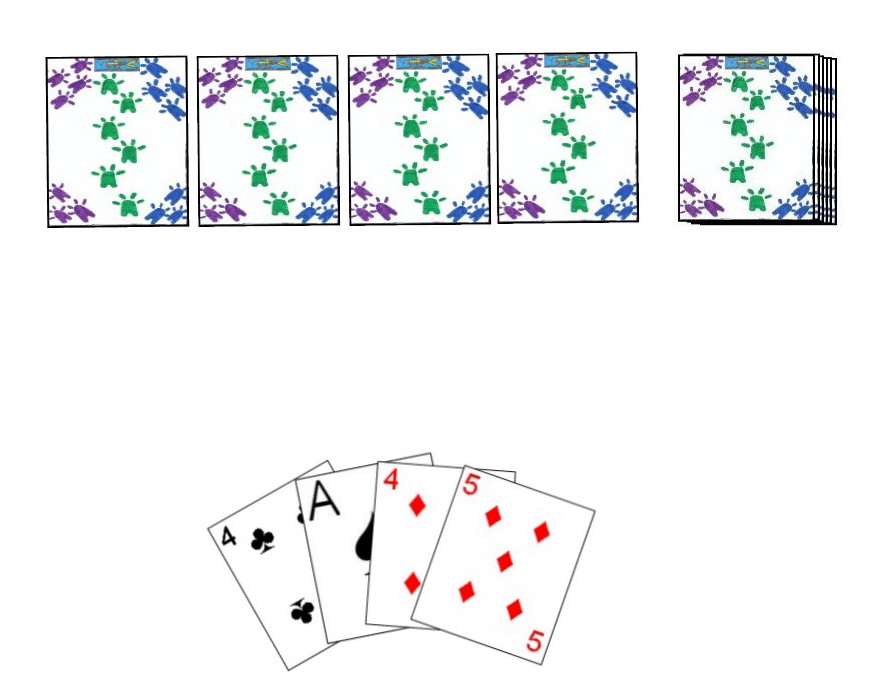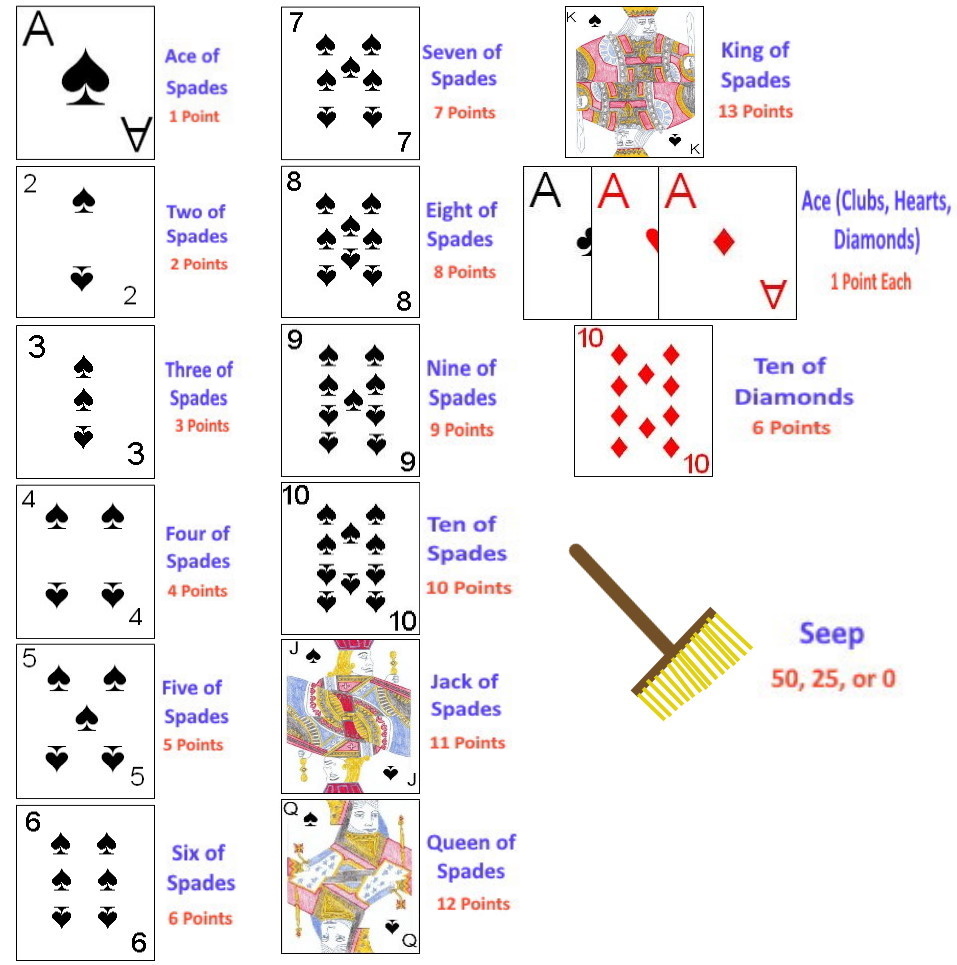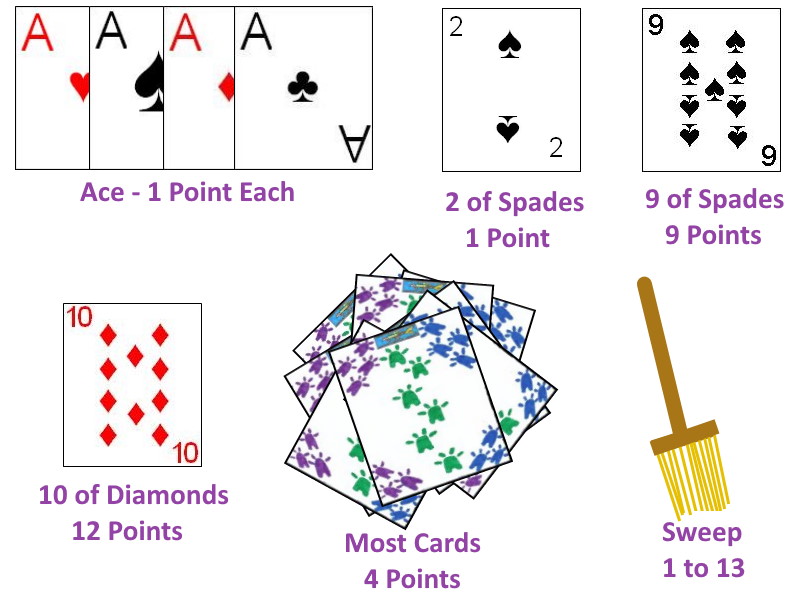The standard game of Seep is designed for play by four players divided into two partnerships. It is played using one standard 52 card deck. Other then in the initial draw for seats, partnerships and first dealer, the cards do not have a relative ranking within the deck.
The first order of business in a game of Seep is usually to determine partnerships, if this has not already been arranged. A common method of doing this is for each player to draw a card from the shuffled deck. The players drawing the two highest cards will play as partners against those drawing the two lowest. If three or more players draw cards of the same denomination, those players should discard and draw new cards. The player drawing the highest card of all has first choice of seats at the table and is set as the first dealer. The partner of the dealer should sit directly across the table from the dealer and the remaining two players should sit directly across from each other at the table, between the dealer and his partner. The ranking of the cards for this draw are as follows (from highest to lowest); Ace, King, Queen, Jack, 10, 9, 8, 7, 6, 5, 4, 3, 2. After each hand, either member of the partnership who has fewer points is set as the dealer for the next hand.
 |
| If the first bidder's hand contains no cards higher than an eight, he must show the hand to the other players and a new hand is dealt. |
Once a bid has been made, the four face-down cards placed in the center of the table are exposed, being turned face-up. The bidding player must then make one of three valid plays:
- Create a House of the Value as made in his bid: This is done by adding one card from the hand and combining that card with one or more cards currently found on the table to total the amount of the bid.
- Play a card of the same value as bid, which matches one or more other cards of that same value on the table. If this play is made, the player takes the card played as well as any other cards of that same denomination matched on the table, placing these cards into his capture pile.
- Place a card equal in value to the bid onto the table. This is done if neither of the two previous play options can be made by the player.
After the bidding player has his turn, the dealer completes the deal, dealing out the remainder of the cards in face-down four card packets to each player in a counterclockwise direction. Upon completion of the deal, the bidding player will have 11 cards in hand (having already played one for his first turn), and each other player will have a hand consisting of 12 total cards.
After the dealer has completed distributing the remainder of the cards, the player to the immediate right of the bidder than has the next turn. The turns rotate in a counter-clockwise direction around the table and each turn consists of a player playing one card from his hand, face-up to the table. On his turn, each player may then make one of several plays:
- Create a House: A house is created when a player adds a card to one or more existing loose cards on the table. These cards are all piled close together to indicate they are part of such a house and may only be captured with a card which has that same capture total capture value as the full value of that house. A player may never create a house unless he has a card in his hand which could be used to, on a later turn, capture that house. The player who creates this House is considered the current Owner of that house. To be considered a valid House, it must have a total capture value of 9, 10, 11, 12, or 13.
- Adding to a House (Cementing): If a player has a card in his hand which either by itself, or added to other loose cards on the table, has the same value as an existing House on the board, he may add that or those cards to the House, called Cementing that house. The House has the same capture value, however it cannot be increased or broken by any other player. In order to add to an existing house already owned by an opponent, the player doing so must also have a card in the hand of the same capture value as that house. The player increasing the value of the house is considered the second owner of that house. However, to add to a House which is already owned by the player's partner, a player need not necessarily have a card in hand which could be used to capture that House.
- Increasing the value of a House: A player may add a card to an existing House to increase the value of that house (called breaking the House). A player may never increase the value of a Cemented House, and in order to increase the value of an ordinary House he must have a card in his hand of a value which could capture the newly increased value of that house. A player may never increase the value of his own house, but may do so with Houses in which an opponent or his partner are the current owner. The player who increased the value of the House is considered to be the new owner. The new house must have a capture value no higher than 13. A player may also increase the value of a House on the table to the value of another House on the table, combining the cards from this House to that of the other. The combined House, if not already, will become a Cemented House.
- Capture Loose Cards: If a player is able to play a card which matches the value of one or more other loose cards (cards not part of an existing House), he may take both his played card and those other cards, adding them to his capture pile. Additionally, if there are two or more loose cards, when summed together, have a capture value exactly equal to the played cards, those may be collected as well, added to that player's capture pile.
- If a player has a card which equals the current Capture value of a House currently found on the table, he may play such a card to capture that House, adding the card played and the cards comprising the House into his capture pile.
- If a player has no other plays he may simply play any card from his hand face-up onto the table as a loose card.

Note that capture plays may be combined. If a player is able, with the same card played to the table, capture a house of that same value, as well as any loose cards or combinations of loose cards he may capture all such cards or combinations of cards, adding them to his capture pile. If a card played could capture a house or loose cards, the player must do so.
As noted, each card in the deck has a specific value which is used to determine it's capture value. The following chart shows the values for each card in the deck:
| Card | Build or Capture Value |
|---|---|
| Ace | 1 |
| 2, 3, 4, 5, 6, 7, 8, 9, 10 | Value as marked on card |
| Jack | 11 |
| Queen | 12 |
| King | 13 |
 Scoring: There are two methods of scoring in this game. The first method is the capture of certain point scoring cards. At the end of the hand, both members of a partnership combine the cards from his capture pile into one pile. The pile from each partnership is then examined, and certain cards as found in these piles will earn that partnership a number of points:
Scoring: There are two methods of scoring in this game. The first method is the capture of certain point scoring cards. At the end of the hand, both members of a partnership combine the cards from his capture pile into one pile. The pile from each partnership is then examined, and certain cards as found in these piles will earn that partnership a number of points:
- Spades: Each card captured in the suit of spades has a corresponding point value, which is equal to that card's capture value. Thus, the Ace of spades is worth 1 point, the numbered cards 2 to 10 (of spades) are each worth the value marked on the card, the Jack of spades has a value of 11 points, the Queen of spades 12 and the King of spades 13 points.
- Aces: Other than the Ace of spades (which is already worth one point) the three other Aces (Ace of clubs, Ace of hearts and Ace of diamonds) are worth one point each.
- Ten of Diamonds: The ten of diamonds has a scoring value of six points for the partnership which manages to capture it.
The second method of scoring in this are Sweeps (also called seeps). A Sweep occurs if a player manages to capture every card remaining on the table in one play. A Sweep on the very first play of the hand earns that player's partnership a bonus of 25 points. A Sweep on the very last play of the game, however, entitles that player to no bonus points. On any other turn of the game, performing a Sweep earns that player's partnership 50 bonus points.
At the end of each hand the total scores earned by both partnerships is then compared. If one team fails to earn at least nine points, that team is said to immediately lose one game (or game point also called a Baazi), and the opposing team is set as the winner of that game. However, if both teams manage to score at least nine points during the hand, the scores are compared and the team earning the higher score during the hand is entitled to add the different in score to an ongoing total for that team. Once the total difference between the two teams, over any number of games, becomes 100 or more, the team with the higher score then wins one game (which is called a Baazi). At any time a Baazi is won, the scores of both partnerships are reset to zero and the next hand starts the next game or Baazi. Thus, over a full game session, the team with the most Baazis is set as the overall session winner.
